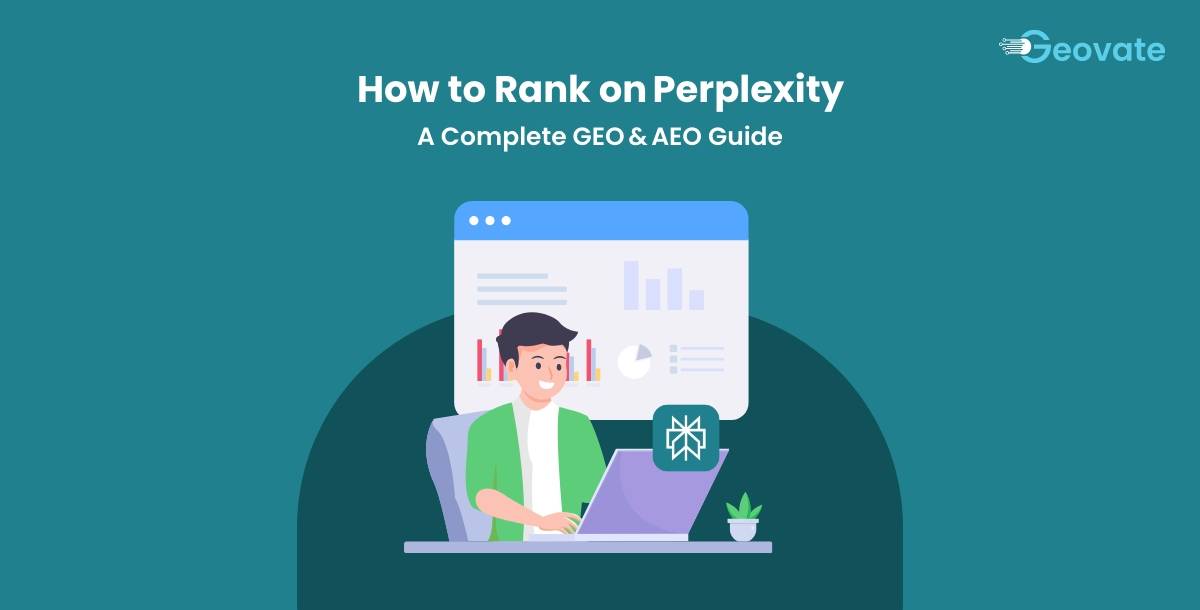How to Rank on Perplexity: A Complete GEO & AEO Guide
Wed,30 Jul 2025 12:35:00- Font Size
- Share Content

Perplexity.ai is rapidly emerging as a must‐have channel for B2B brands to capture demand at the moment of need. Understanding how to rank on Perplexity and how to rank in Perplexity requires blending traditional SEO best practices with specialized Generative Engine Optimization (GEO) techniques. In this guide, we’ll walk through everything you need to know—from getting indexed to continuous content refreshes—so you can nail your Perplexity ranking and leverage a Perplexity AEO service approach that drives real business outcomes.
What Is Perplexity.ai and Why It Matters
Perplexity.ai is an AI‑powered search engine that combines web crawling with large language models to deliver clear, concise answers rather than a list of links. Unlike traditional search, Perplexity’s Sonar algorithm prioritizes pages that not only rank well on Google but are also structured for rapid AI consumption, creating a new frontier in perplexity geo and geo Perplexity optimization. For brands, appearing in Perplexity answers means being the definitive source—an incredible trust signal that accelerates buyer journeys.
How Perplexity’s Sonar Algorithm Works
Perplexity’s core ranking engine, Sonar, ingests three primary signals:
- Google SERP performance: Pages that rank in top organic spots are favored.
- Semantic depth and clarity: AI‑friendly content with tightly focused, NLP‑optimised answers wins.
- Structured data markup: JSON‑LD schemas (FAQPage, HowTo) dramatically boost citation likelihood.
Beyond these, factors like domain authority, backlinks, and content freshness also feed into Sonar’s decision‑making. Mastering these signals is the foundation of how to rank on Perplexity effectively.
Getting Indexed: Submission & Crawl‑Readiness
Before you can worry about citations and answer formatting, your site must be discoverable by Perplexity. Since Perplexity relies on Bing’s index:
1. Implement IndexNow for Instant Alerts
IndexNow is an API protocol that instantly notifies Bing (and thereby Perplexity) whenever you publish or update content. To set this up:
- Register an IndexNow key via or through CMS plugins (e.g., Yoast, Rank Math).
- Automate URL submissions upon publish/update, ensuring your freshest content is always eligible for Perplexity ranking.
2. Conduct a Crawlability Audit
Ensure bots can reach and interpret your pages:
- Maintain a clean XML sitemap and robots.txt (avoid blocking critical sections).
- Use canonical tags to prevent dilution via duplicate content.
- Run tools like Screaming Frog or Sitebulb to identify crawl errors and fix them promptly.
3. Verify Indexing Status
Regularly confirm that your key pages are indexed by Bing:
- Use Bing Webmaster Tools or site:yourdomain.com operators to check.
- If missing, troubleshoot crawl blocks, resubmit via IndexNow, or adjust your site architecture accordingly.
On‑Page Optimization for AI‑Friendly Content
Once indexed, focus on crafting content Perplexity can easily parse and cite.
Lead with Direct, Answer‑First Headers
Structure every H2/H3 as a clear question or benefit, immediately followed by a concise answer. For example:
How do I optimize my pages for Perplexity.ai?
Use question‐style headings, followed by a 1–2 sentence answer, then expand as needed.
This “answer‐first” approach maximizes your chances of being pulled as a direct citation.
Write LLM‑Friendly, Concise Copy
AI models excel when parsing content that is
- Short sentences (≤25 words) in active voice
- Clearly signposted facts before deeper context
- Free of fluff and filler so that Perplexity geo and geo perplexity parsing yield the precise data needed.
Use Lists, Tables, and Bullets
Present step‑by‑step instructions, comparisons, or feature sets in bulleted lists or tables. This not only aids readers but also gives Perplexity copyable snippets for citations:
- Step 1: Set up IndexNow API key
- Step 2: Automate URL submissions
- Step 3: Audit crawlability quarterly
Natural, Strategic Keyword Placement
Incorporate your primary keywords—how to rank on Perplexity, how to rank in Perplexity, Perplexity ranking, Perplexity AEO service, Perplexity GEO Services, and GEO Perplexity—in headings, first paragraphs, and alt text, but never at the expense of readability.
Implementing Structured Data for Maximum Visibility
Structured data tells Perplexity exactly what each section of your page represents, greatly increasing the chance of direct inclusion.
JSON‑LD Markup Essentials
Apply standard schemas:
FAQPage for common questions:
{
"@context": "https://schema.org",
"@type": "FAQPage",
"mainEntity": [
{
"@type": "Question",
"name": "How long before Perplexity.ai indexes my content?",
"acceptedAnswer": {
"@type": "Answer",
"text": "Typically within 24–48 hours after Bing indexation via IndexNow."
}
}
]
}
Always validate your markup with Google’s Rich Results Test and the Schema.org validator before publishing.
Embracing Perplexity AEO Service and Perplexity GEO Strategies
Generative Engine Optimization (GEO) and Answer Engine Optimization (AEO) represent the new SEO frontier:
- Perplexity AEO service focuses on delivering direct answers that AI can pull into query responses. This means writing with zero-click visibility in mind.
- Perplexity GEO (geo perplexity) ensures your content architecture, metadata, and semantics align with AI consumption patterns. Think “spider‑web” internal linking that signals topic clusters and authority.
By combining AEO and GEO principles—concise Q&A, structured data, strategic linking—you create content that not only ranks well but also becomes a go‑to resource for AI summaries.
Continuous Content Refreshes: Staying Competitive in Perplexity
Freshness is a core Sonar signal. To maintain and improve your Perplexity ranking, implement:
- Quarterly Audits: Schedule content reviews to update stats, images, and FAQs.
- FAQ Expansion: Regularly add new user queries driven by analytics, customer feedback, and trending topics.
- Automated Reminders: Use editorial workflows to trigger IndexNow resubmissions after each major update.
This cycle of publish–audit–update keeps your pages at peak performance for both human and AI consumption.
Tracking Performance and Demonstrating ROI
Without measurement, GEO efforts remain guesswork. Here’s how to track Perplexity‑driven impact:
1. Citation Tracking
Leverage tools like RankScale.ai or FalconRank to monitor when and where Perplexity cites your URLs. Record gains and losses in a central dashboard.
2. Analytics & Attribution
- Create UTM parameters for pages you optimize for Perplexity.
- Set up a dedicated “AI Search” channel in Google Analytics or Looker Studio to isolate Perplexity referrals and conversions.
3. Stakeholder Reporting
Compile monthly snapshots with charts, revenue impact, and key wins. Visualizing improved perplexity ranking alongside pipeline lift builds buy‑in for ongoing AEO/GEO investment.
Putting It All Together: A Step‑by‑Step Action Plan
- IndexNow & Bing Submission – Register and automate via API plug‑ins.
- Site Crawl & Sitemap – Ensure crawlability and fix issues.
- Answer‑First Content – Revise all key pages for direct Q&A structure.
- Structured Data – Implement and validate JSON‑LD for FAQ and HowTo schemas.
- Keyword & Semantic Integration – Naturally weave in how to rank on perplexity, how to rank in perplexity, perplexity ranking, perplexity aeo service, perplexity geo, and geo perplexity.
- Internal Linking – Build hub‑and‑spoke content clusters.
- Quarterly Refresh – Audit, update, and resubmit via IndexNow.
- Performance Monitoring – Track citations, referrals, and conversions; report ROI.
Conclusion:
Mastering how to rank in Perplexity is less about guesswork and more about systematic execution of classic SEO married to next‑gen GEO/AEO tactics. By prioritizing instant indexation, AI‑friendly content structure, robust structured data, and a relentless refresh cycle, you’ll position your brand at the very top of Perplexity answers. And by tracking and demonstrating ROI, you’ll secure the budget and support to keep dominating this emerging channel.
Ready to elevate your Perplexity presence? Implement this guide’s steps, monitor your Perplexity ranking, and watch as your content becomes the authoritative source for AI‑powered searchers everywhere.
Frequently Asked Questions (FAQ)
Q1. How long does it take for Perplexity.ai to index new content?
A. Perplexity.ai typically indexes new or updated content within 24–48 hours after it’s crawled by Bing. Using IndexNow can speed this process by notifying Bing immediately when you publish or update a page.
Q2. What is the best way to structure content for Perplexity ranking?
A. Use question‑style H2s/H3s with concise, answer‑first paragraphs. Break information into bullet lists or numbered steps, and include JSON‑LD FAQPage or How To schemas to increase citation likelihood.
Q3. How often should I refresh content to maintain a top Perplexity ranking?
A. We recommend a quarterly review cycle: update data, add new FAQs, refine examples, then resubmit via IndexNow. This keeps your content fresh for both human readers and Perplexity’s Sonar algorithm.
Q4. Can I track when Perplexity.ai cites my content?
A. Yes—tools like RankScale.ai or FalconRank monitor Perplexity citations. Combine that with UTM parameters and a dedicated “AI Search” channel in your analytics to measure referral traffic and conversions.
Q5. What role do GEO and AEO play in Perplexity optimization?
A. GEO (Generative Engine Optimization) ensures your content architecture and semantics align with AI consumption, while AEO (Answer Engine Optimization) focuses on zero‑click, direct‑answer formats. Together, they maximize visibility in Perplexity.ai.
